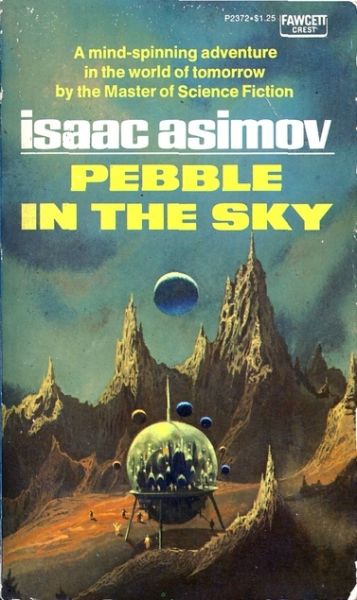Secrets Stolen From Deep Inside
Pebble in the Sky (Trantorian Empire, volume 1)
By Isaac Asimov

1 Dec, 2019
Asimov’s 1950 Pebble in the Sky is either the first (by publication date) or the third (by internal chronology) of three standalone novels (The Stars, Like Dust, The Currents of Space, and Pebble in the Sky) set some millennia prior to the beginning of the Foundation trilogy. The three novels form a loose trilogy that has been dubbed the Empire novels or sometimes the Galactic Empirenovels.
The Stars, Like Dustis set long before Trantor began its rise to power; The Currents of Space is set during its rise. Pebble in the Sky is set at the height of the Galactic Empire’s power.
The book opens with an Eisenhower-era tailor, Joseph Schwartz, who finds himself transported onto a desolate alien world. He later learns that he is still on Earth, an Earth of the far future. The plant has been scoured by nuclear war. Even though this happened some time ago, Earth is still radioactive in places and is largely sterile.
Schwartz encounters two locals, who take him to Dr. Shekt, a scientist at the Nuclear Institute. An enigma is best handled by a scientist. Shekt turns out to be a failure as a protector. He uses Schwartz as an unwitting human test subject for his new invention, a synapiser1.
Schwartz survives, mostly. He’s lost some memories. He may also have gained some intelligence. He really has gained some telepathic ability. Consequently, he is drawn into Earth’s unpleasant politics.
In this era, Earth is a backwater planet, a minor constituent of the great Galactic Empire. Earth itself is so poor that retaining a stable population of twenty million requires great sacrifices, such as euthanasia of the elderly to make room for babies. As far as the Empire is concerned, Earth is a festering boil, a dirt-poor world that rebels against the enlightened rule of its betters.
Offworlder Arvardan is one of the few Galactics who credit the terrestrial conviction that Earth was the world on which humanity arose. One might expect that this would endear him to the locals. It does not. Earthmen have very little use for any oppressor, not even one in love with an Earthwoman (Pola, Shekt’s daughter).
Coincidence places both Arvardan and Schwartz in the crosshairs of a deadly conspiracy. Previously, Earth tried to win freedom by driving the Empire off Earth. This proved impossible because for every human alive on Earth, the Empire has ten inhabitable worlds. Earth simply could not overcome odds of tens of billions to one.
Balkis, secretary of the High Minister of Earth, has a bold solution. Earth isn’t just a windswept radioactive desolation. It is home to a myriad of communicable diseases. If these diseases were to be weaponized by local researchers (whose brilliance would amplified by Shekt’s synapsiser) these diseases could depopulate all two hundred million worlds of the Empire. Earth will be supreme once more!
Provided Arvardan and Schwartz can be silenced in time….
~oOo~
Canadian public education didn’t go in for Greek and Roman history. In fact, little not directly related to the history of Britain made it onto the curriculum (our grade nine text, for example, ignored most of the world beyond Normandy, and strongly implied that history ended in the summer of 1914). The history of the Middle East under Roman rule was to some extent covered by morning Bible readings (which were a thing back then) and popular entertainment. I learned history from movies like Ben Hur and TV shows like I, Claudius.
Consequently, when I first read this novel almost half a century ago, I completely missed the fact that it was inspired by history. Just as Asimov lifted many ideas for Foundation from Edward Gibbon’s The History of the Decline and Fall of the Roman Empire, he found inspiration for Pebble from the Judean hatred of their Roman conquerors.
Asimov prettied up history. The Galactic Empire is much nicer to its possessions than Rome ever was. This is a low bar but still … the Galactics are benign enough that attempted galactic genocide seems a bit of an overreaction by the Earthers.
I hope it’s not a spoiler to say that things turn out better for the Earthers than Masada did for the Judeans.
Asimov clearly put a lot of effort into the setting of this novel. His characters are, as usual, slight; his prose is competent (by pulp standards) but no better than that. Modern readers may find Pebbleextremely slight. This may explain why the book had been so long out of print when I reviewed this for the SFBC some twenty years ago. I was lucky to find a half-century-old hardcover still in circulation in the local library system.
Pebble in the Sky is available here (Amazon US), here (Amazon Canada), here (Amazon UK), and here (Chapters-Indigo).
1: I am unsure why neurological research is happening at a Nuclear Institute.
